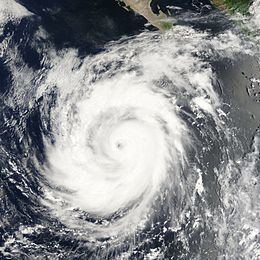Formed August 21, 2006 Fatalities 1 direct Areas affected Mexico, Socorro Island Affected areas Mexico, Socorro Island | Dissipated August 27, 2006 Damage Minimal Highest winds 193 km/h | |
 | ||
Lowest pressure 955 mbar (hPa); 28.2 inHg Date 21 August 2006 – 27 August 2006 Similar Hurricane Paul, Hurricane Kristy, Hurricane Sergio, Tropical Storm Emilia, Hurricane Lane | ||
Hurricane Ileana was the fourth of six major hurricanes in the 2006 Pacific hurricane season. Forming from a tropical wave on August 21, Ileana tracked northwestward off the coast of Mexico throughout its duration. With favorable conditions for intensification, Ileana reached peak winds of 120 mph (195 km/h) within 48 hours of forming. Near peak intensity it passed near Socorro Island, and subsequently began to weaken due to cooler waters. On August 27 Ileana weakened to a remnant low, which dissipated two days later. The hurricane produced heavy rainfall along the Mexican coastline, causing flooding, and one person was killed due to strong waves.
Contents
Meteorological history
A tropical wave moved off the coast of Africa on August 8, which subsequently tracked westward across the Atlantic Ocean with minimal convection. The wave crossed into the eastern Pacific Ocean on August 16, at which time convection increased along the wave axis. Three days later, a weak low pressure area formed along the wave, and early on August 20 some broad cyclonic turning was evident within the cloud pattern. Gradually, banding features developed around the area of deep convection, and the system was expect to develop further as it moved into an increasingly favorable environment. Convection increased late on August 20, although it initially remained disorganized; however, the thunderstorms consolidated near the low, and it is estimated the system developed into a tropical depression by 1200 UTC on August 21, about 350 mi (560 km) south-southwest of Acapulco, Mexico.
A mid-level ridge over Mexico caused the cyclone to track steadily northwestward. With warm water temperatures and low vertical wind shear, the depression quickly intensified into Tropical Storm Ileana. Convection developed and organized into a central dense overcast, and with abundant low-level moisture, rapid deepening was expected. An eye formed in the center of the convection, and Ileana attained hurricane status late on August 22. On August 23, about 48 hours after forming, Ileana reached major hurricane status and a peak intensity of 120 mph (195 km/h) about 60 mi (100 km) southeast of Socorro Island. It also attained an atmospheric pressure of 955 mbar, as well as an eye diameter of 23 mi (37 km).
Initially, Ileana was forecast to intensify further to reach Category 4 status on the Saffir-Simpson scale. After passing south of Socorro Island, the hurricane began a slow weakening trend due to cooler waters; as the winds decreased, the eye expanded and the thunderstorms waned. The ridge to its north weakened, causing the storm to slow and turn more to the west-northwest. Early on August 26, Ileana weakened to tropical storm status. Later that day, convection decreased markedly, and early on August 27 it deteriorated to tropical depression status. By late on August 27, Ileana had been without deep convection for about 18 hours, and so degenerated into a broad remnant low. It continued slowly westward, dissipating on August 29 about 830 mi (1340 km) west-northwest of Cabo San Lucas.
Preparations and impact
Hurricane Ileana never significantly impacted land, and no tropical cyclone warnings or watches for the storm. While near peak intensity, it passed 60 mi (100 km) south of the unpopulated Socorro Island; a station on the island recorded sustained winds of 59 mph (95 km/h), with gusts to 77 mph (125 km/h). The hurricane dropped heavy rainfall along the Mexican coastline, causing flooding in Nayarit, Jalisco, Colima, Michoacán, and Baja California Sur. High surf from Ileana reached the coast, killing one man near Cabo San Lucas despite warnings not to swim in the ocean.
